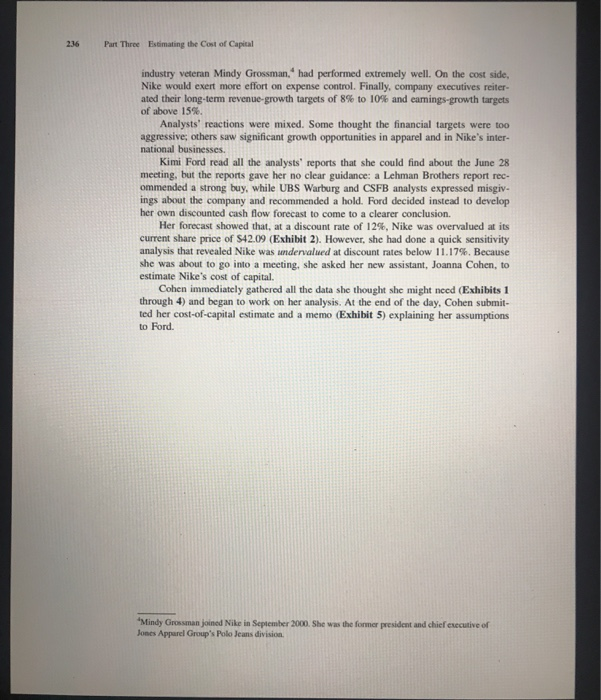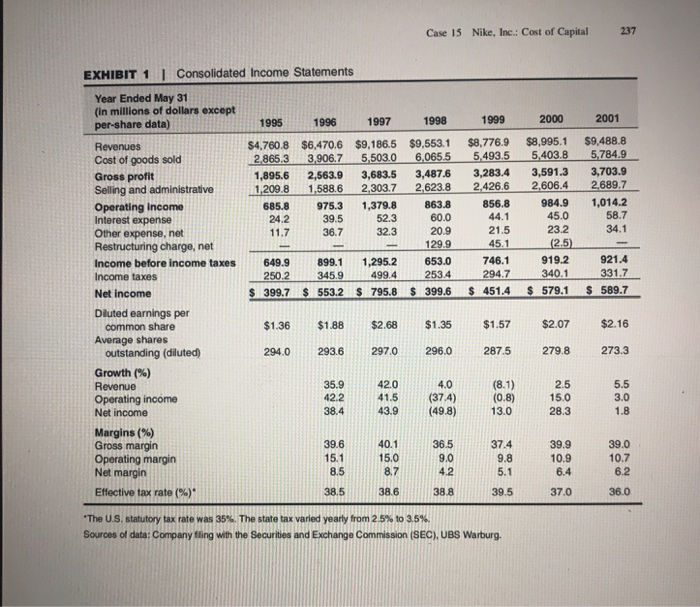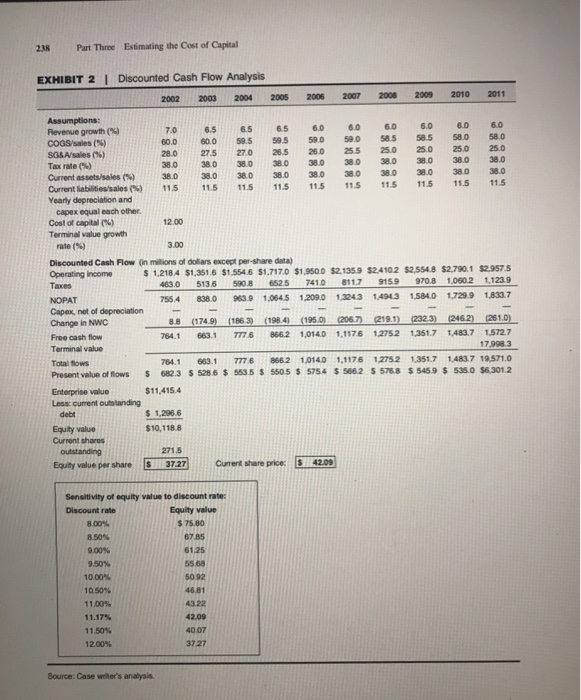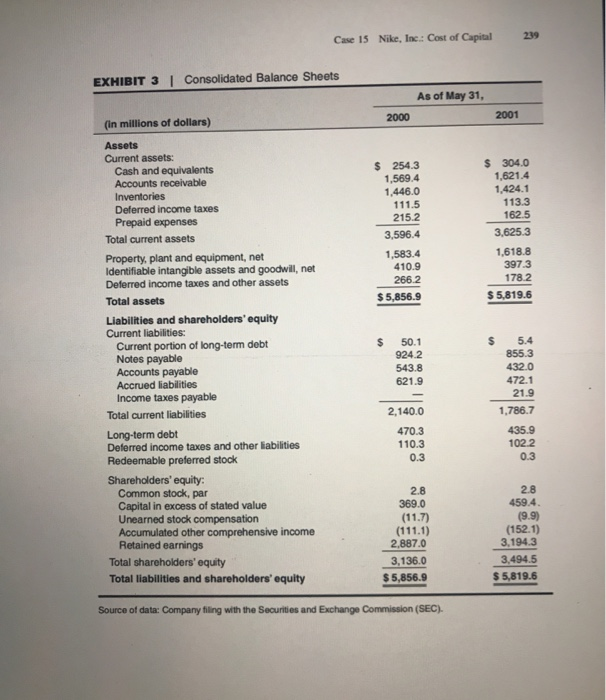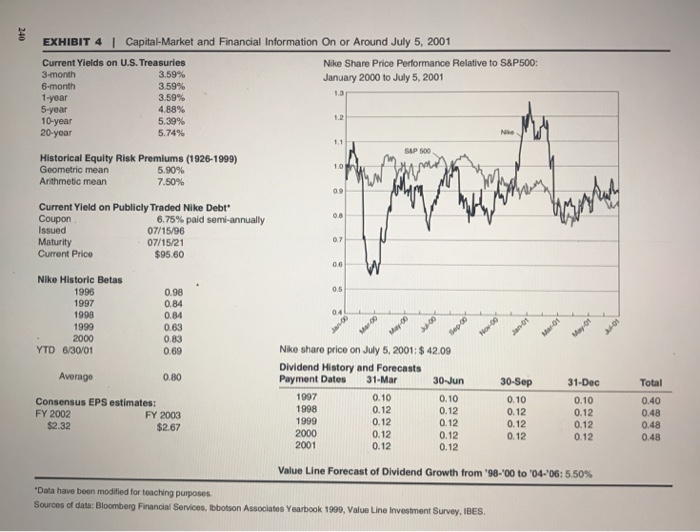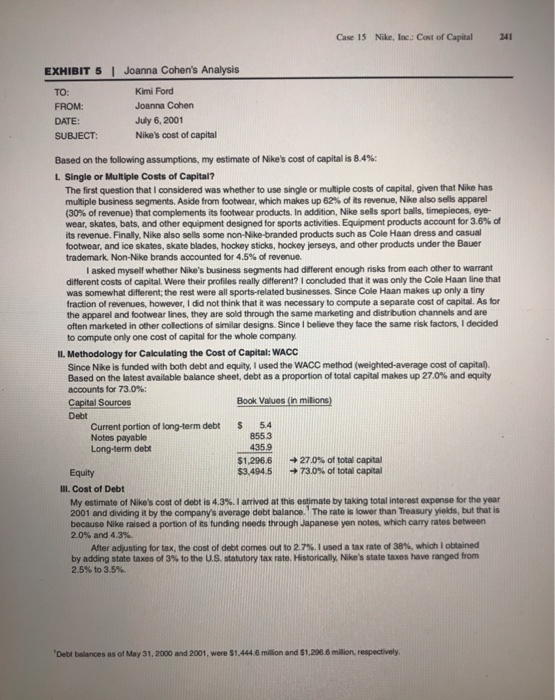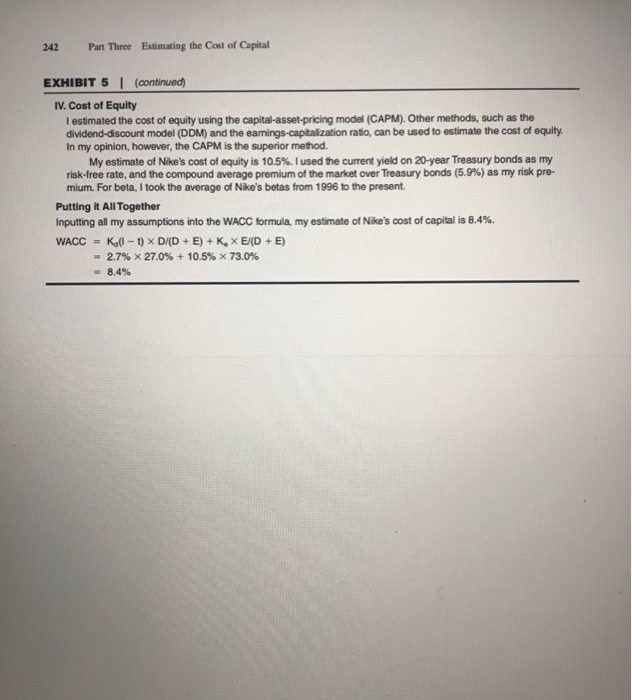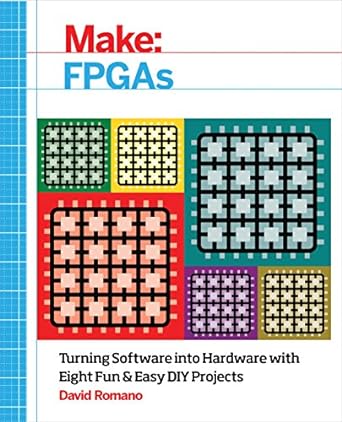1. Do you agree with Joanna Cohen's WACC calculation? Why or why not? You must provide your reasons for every disagreement! Even if you disagree on one point, then you must calculate your own WACC for NIKE Inc. Do it and show your work.
2. What should Kimi Ford recommend regarding an investment in Nike?
3. Calculate the costs of equity? use CAPM and the Dividend Discount Model (DDM)
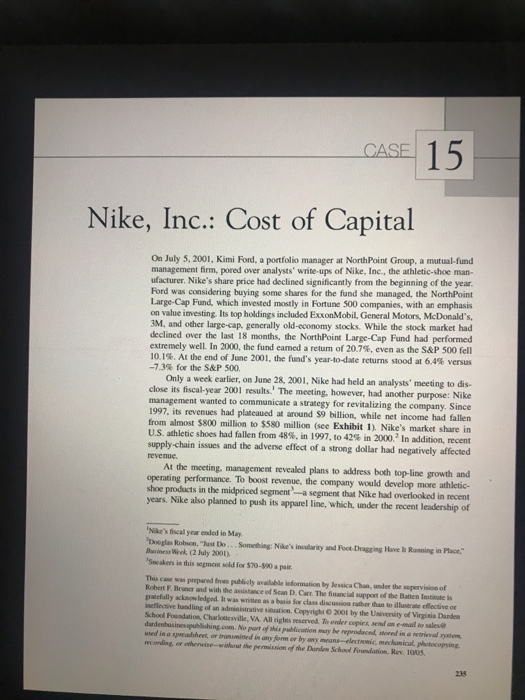
15 CASE Nike, Inc.: Cost of Capital On July 5, 2001, Kimi Ford, a portfolio manager at NorthPoint Group, a mutual-fund management firm, pored over analysts' write-ups of Nike, Inc., the athletic-shoe man- ufacturer. Nike's share price had declined significantly from the beginning of the year Ford was considering buying some shares for the fund she managed, the NorthlPoint Large-Cap Fund, which invested mostly in Fortune 500 companies, with an emphasis on value investing. Its top holdings included ExxonMobil, General Motors, McDonald's, 3M, and other large-cap, generally old-economy stocks. While the stock market had declined over the last 18 months, the NorthPoint Large-Cap Fund had performed extremely well. In 2000, the fund eamed a retum of 20.7 %, even as the S&P 500 fell 10.1%. At the end of June 2001, the fund's year-to-date returns stood at 6.4 % versus -7.3% for the S&P 500 Only a week earlier, on June 28, 2001, Nike had held an analysts' meeting to dis close its fiscal-year 2001 results. The meeting, however, had another purpose: Nike management wanted to communicate a strategy for revitalizing the company. Since 1997, its revenues had plateaued at around $9 billion, while net income had fallen from almost $800 million to $580 million (see Exhibit 1). Nike's market share in U.S. athletic shoes had fallen from 48 %, in 1997, to 42% in 2000 In addition, recent supply-chain issues and the adverse effect of a strong dollar had negatively affected revenue At the meeting, management revealed plans to address both top-line growth and operating performance. To boost revenue, the company would develop more athletic- shoe products in the midpriced segment-a segment that Nike had overlooked in recent years. Nike also planned to push its apparel line, which, under the recent leadership of Nke's fiscal year ended in May Doeglas Robscn, "Just Do... Something: Nike's insularity and Foot Dragging Have It Ranning in Place Business Wiek, (2 July 2001) Sneakers in this segment sold for $70-590 a pair This case was prepared from publicly available information by Jessica Chan, under the upervision of Robert F. Braner and with the asistance of Sean D. Carr The inancial ssapport of the Banen Instinte is gratefally acknowledged. It was written as a basis for class discusion raher than to illtrate efflectsive or ineflective handling of an administrative sinsation. Copyright O 20001 by the Univenity of Virginia Danden School Foundation, Charlonesville, VA All rights reserved. T onder copies send anemail to sales@ dardenbusines spublishing.com. No part of this publication my be reprodaced ored in a netrieval ste uned in a speadsheet, or transmited in any form or by any means-electonic, mechumical phtocopying mcond or otheneise-without the permission of the Dundem School Foundanion. Res 1005 235 236 Part Three Estimating the Cost off Capital industry veteran Mindy Grossman. had performed extremely well. On the cost side, Nike would exert more effort on expense control. Finally, company executives reiter- ated their long-term revenue-growth targets of 8% to 10 % and eamings-growth targets 4 of above 15 %. Analysts' reactions were mixed. Some thought the financial targets were too aggressive; others saw significant growth opportunities in apparel and in Nike's inter- national businesses. Kimi Ford read all the analysts' reports that she could find about the June 28 meeting. but the reports gave her no clear guidance: a Lehman Brothers report rec- ommended a strong buy, while UBS Warburg and CSFB analysts expressed misgiv- ings about the company and recommended a hold. Ford decided instead to develop her own discounted cash flow forecast to come to a clearer conclusion. Her forecast showed that, at a discount rate of 12%, Nike was overvalued at its current share price of $42.09 (Exhibit 2). However, she had done a quick sensitivity analysis that revealed Nike was undervalued at discount rates below 11.17 %. Because she was about to go into a meeting, she asked her new assistant, Joanna Cohen, to estimate Nike's cost of capital. Cohen immediately gathered all the data she thought she might need (Exhibits 1 through 4) and began to work on her analysis. At the end of the day, Cohen submit- ted her cost-of-capital estimate and a memo (Exhibit 5) explaining her assumptions to Ford Mindy Grossman joined Nike in September 2000. She was the former president and chicf executive of Jones Apparel Group's Polo Jeans division Case 15 Nike, Inc.: Cost of Capital EXHIBIT 1 I Consolidated Income Statements Year Ended May 31 (in millions of dollars except per-share data) 2000 2001 1998 1999 1997 1996 1995 $9,488.8 5,784.9 $8,995.1 5,403.8 $8,776.9 5,493.5 $9.186.5 5,503.0 $4,760.8 $6.470.6 2.865.3 $9,553.1 Revenues 6,065.5 Cost of goods sold 3,906.7 3,283.4 2,426.6 3,703.9 2,689.7 3,591.3 3,487.6 1,895.6 2,563.9 1,588.6 3,683.5 Gross profit Selling and administrative 2,606.4 2,623.8 1,209.8 2,303.7 1,014.2 58.7 856.8 984.9 1,379.8 52.3 863.8 685.8 975.3 Operating income Interest expense Other expense, net Restructuring charge, net 45.0 44.1 60.0 24.2 39.5 23.2 34.1 21.5 32.3 20.9 11.7 36.7 (2.5) 129.9 45.1 921.4 746.1 919.2 1,295.2 653.0 649.9 250.2 899.1 Income before income taxes Income taxes 340.1 331.7 294.7 345.9 499.4 253.4 S 589.7 $ 451.4 $579.1 $ 399.7 $ 553.2 $ 795.8 S399.6 Net income Dluted earnings per $2.16 $2.68 $1.35 $1.57 $2.07 $1.36 $1.88 common share Average shares outstanding (diluted) 293.6 279.8 273.3 297.0 296.0 287.5 294.0 Growth(%) Revenue 35.9 42.2 38.4 42.0 41.5 4.0 (8.1) (0.8) 13.0 2.5 15.0 28.3 5.5 Operating income Net income (37.4) (49.8) 3.0 43.9 1.8 Margins (%) Gross margin Operating margin Net margin 39.9 39.0 10.7 39.6 40.1 36.5 37.4 15.0 9.0 15.1 9.8 10.9 6.4 8.5 8.7 4.2 5.1 6.2 Effective tax rate (% ) 38.5 38.8 39.5 36.0 38.6 37.0 The U.S. statutory tax rate was 35%. The state tax varied yearly from 2.5% to 3.5 % . Sources of data: Company filing with the Securities and Exchange Commission (SEC), UBS Warburg. 237 Estimating the Cost of Capital Part Three 238 EXHIBIT 2 I Discounted Cash Flow Analysis 2008 2010 2011 2005 2009 2007 2006 2003 2004 2002 Assumptions: Revenue growth (%) 6.0 6.0 6.0 6.0 6.0 6.5 6.0 6.5 6.5 7.0 58.0 58.0 58.5 58.5 59.5 26.5 59.0 59.5 59.00 60.0 60.0 COGS/sales (%) 25.0 25.0 25.0 25.5 25.0 26.0 27.5 27.0 28.0 SGSAsales () 38.0 38.0 38.0 38.0 38.0 38.0 38.0 38.0 38.0 38.0 Tax rate (%) Current assets/sales (%) Current liabilities'sales (%) Yearly depreciation and capex equal each other. Cost of capital ) Terminal value growth rate (%) 38.0 38.0 38.0 38.0 38.0 38.0 38.0 380 38.0 38.0 11.5 11.5 11.5 11.5 11.5 11.5 11.5 11.5 11.5 11.5 12.00 3.00 Discounted Cash Flow (in milions of dollars except per-share data) Operating income S1,2184 $1,351.6 $1.554 6 $1,717.0 $1.9500 $2.135.9 $24102 $2554.8 $2.790.1 $2.957.5 7410 1,060.2 1.123.9 915.9 970.8 590.8 811.7 6525 463.0 513.6 Taxes 1,729 9 1,833.7 1,584.0 963.9 1,0645 1,209.0 1,3243 1494.3 755.4 838.0 NOPAT Capex, net of depreciation Change in NWC (261.0) (206.7) (219.1) (232.3) (246.2) (195.0 (198.4) 8.8 (174.9) (186.3) 12752 1,351.7 1,483.7 1,572.7 777 6 866.2 1,014.0 1.117.6 663.1 764.1 Free cash flow 17.998.3 Terminal value 1,483.7 19.571.0 866.2 1,014.0 1,1176 1275.2 1.351.7 663.1 777.6 764.1 Total flows 682.3 S 528.6 $ 553.5 $ 550 5 $ 575.4 $566.2 $ 576 8 $ 545.9 $ 535.0 $6.301.2 S Present value of flows $11,415.4 Enterprise value Less: ourent outstandings debt S1,296.6 Equity value Current shares $10,118.8 271.5 outstanding 37.27 42.09 Current share price Equity value per share- Sensitivity of equity value to discount rate: Equity value Discount rate 8.00% $75.80 8.50% 67.85 9.00% 61.25 950 % 55.68 10.00 % 50.92 10.50% 46.81 43.22 11.00% 11.17% 42.09 40.07 11.50% 37 12.00% Source: Case writer's analysis. 239 Case 15 Nike, Inc.: Cost of Capital EXHIBIT 3 I Consolidated Balance Sheets As of May 31, 2001 2000 (in millions of dollars) Assets Current assets: Cash and equivalents $ 304.0 1,621.4 1,424.1 113.3 162.5 $ 254.3 1,569.4 Accounts receivable Inventories Deferred income taxes 1,446.0 111.5 215.2 Prepaid expenses 3,625.3 3,596.4 Total current assets 1,618.8 397.3 178.2 1,583.4 410.9 Property, plant and equipment, net Identifiable intangible assets and goodwill, net Deferred income taxes and other assets 266.2 $ 5,819.6 $5,856.9 Total assets Liabilities and shareholders' equity Current liabilities: 5.4 855.3 432.0 50.1 Current portion of long-term debt Notes payable Accounts payable Accrued liabilities Income taxes payable 924.2 543.8 472.1 621.9 21.9 1,786.7 2,140.0 Total current liabilities 435.9 470.3 Long-term debt Deferred income taxes and other liabilities Redeemable preferred stock 110.3 0.3 102.2 0.3 Shareholders' equity: Common stock, par Capital in excess of stated value Unearned stock compensation Accumulated other comprehensive income Retained earnings 2.8 459.4. 2.8 369.0 (9.9) (152.1) 3,194.3 (11.7) (111.1) 2,887.0 3,494.5 Total shareholders' equity 3,136.0 $ 5,819.6 $5,856.9 Total liabilities and shareholders' equity Source of data: Company filing with the Securities and Exchange Commission (SEC) EXHIBIT 4 | Capital-Market and Financial Information On or Around July 5, 2001 Current Yields on U.S. Treasuries Nike Share Price Performance Relative to S&P500: 3-month 3.59% 6-month 1-year 5-year 10-year 20-yoar January 2000 to July 5, 2001 3.59% 3.59% 1.3 4.88% 5.39% 5.74% Nke. 1.1 Historical Equity Risk Premiums (1926-1999) Geometric mean Arithmetic mean SAP 500 5.90% 7.50% 1.0 0.9 Current Yield on Publicly Traded Nike Debt Coupon Issued Maturity Current Price 6.75% paid semi-annually 07/15/96 07/15/21 $95.60 0.7 06 Nike Historic Betas 1996 0.98 0.5 1997 0.84 1998 1999 0.84 04 0.63 0.83 Nike share price on July 5, 2001: $ 42.09 Sep-00 2000 Jan-0 Mar00 J00 YTD 6/30/01 Nov-00 Mar01 Jd-01 0.69 May-01 Average Dividend History and Forecasts Payment Dates 0.80 31-Mar 30-Jun 30-Sep Consensus EPS estimates: FY 2002 $2.32 31-Dec 1997 1998 1999 2000 2001 Total 0.10 0.10 0.10 FY 2003 0.10 0.12 0.12 0.12 0.12 0.40 0.12 0.12 0.12 0.12 $2.67 0.12 0.12 0.48 0.48 0.12 0.12 0.12 0.12 Value Line Forecast of Dividend Growth from '98-00 to '04-06: 5.50% Data have been modified for teaching purposes Sources of data: Bloomberg Financial Services, Ibbotson Associates Yearbook 1999, Value Line Investment Survey, IBES. 40uer 240 Case 15 Nike, Inc.: Cost of Capital 241 EXHIBIT 5 Joanna Cohen's Analysis Kimi Ford TO: Joanna Cohen FROM: DATE: July 6, 2001 SUBJECT Nike's cost of capital Based on the following assumptions, my estimate of Nike's cost of capital is 8.4% L Single or Multiple Costs of Capital? The first question that I considered was whether to use single or multiple costs of capital, given that Nike has multiple business segments. Aside from footwear, which makes up 62% of its revenue, Nike also sells apparel (30% of revenue) that complements its footwear products. In addition, Nike sells sport balls, timepieces, eye- wear, skates, bats, and other equipment designed for sports activities. Equipment products account for 3.6% of its revenue. Finally, Nike also sells some non-Nike-branded products such as Cole Haan dress and casual footwear, and ice skates, skate blades, hockey sticks, hockey jerseys, and other products under the Bauer trademark. Non-Nike brands accounted for 4.5% of revenue. I asked myself whether Nike's business segments had different enough risks from each other to warrant different costs of capital. Were their profiles really different? I concluded that it was only the Cole Haan line that was somewhat different; the rest were all sports-related businesses. Since Cole Haan makes up only a tiny fraction of revenues, however, I did not think that it was necessary to compute a separate cost of capital. As for the apparel and footwear lines, they are sold through the same marketing and distribution channels and are often marketed in other colections of similar designs. Since I believe they face the same risk factors, I decided to compute only one cost of capital for the whole company I. Methodology for Calculating the Cost of Capital: WACC Since Nike is funded with both debt and equity, I used the WACC method (weighted-average cost of capital). Based on the latest available balance sheet, debt as a proportion of total capital makes up 27.0 % and equity accounts for 73.0% Book Values (in milions) Capital Sources Debt S Current portion of long-term debt payable Long-term debt 5.4 855.3 435.9 27.0% of total capital 73.0 % of total capital $1,206.6 $3,494.5 Equity II. Cost of Debt My estimate of Nike's cost of debt is 4.3% .I arrived at this estimate by taking total interest expense for the year 2001 and dividing it by the company's average debt balance. The rate is lower than Treasury yields, but that is because Nike raised a portion of its funding needs through Japanese yen notes, which cary rates between 2.0% and 4.3 % After adjusting for tax, the cost of debt comes out to 2.7%. I used a tax rate of 38%, which I obtained by adding state taxes of 3% to the U.S. statutory tax rate, Historically, Nike's state taxes have ranged from 2.5% to 3.5 % Debt balances as of May 31, 2000 and 2001, were $1,444.6 millon and $1,296.6 million, respectively. Part Three Estimating the Cost of Capital 242 EXHIBIT 5I (continued) IV. Cost of Equity I estimated the cost of equity using the capital-asset-pricing model (CAPM). Other methods, such as the dividend-discount model (DDM) and the eanings-capitalization ratio, can be used to estimate the cost of equity In my opinion, however, the CAPM is the superior method. My estimate of Nike's cost of equity is 10.5 %. I used the current yield on 20-year Treasury bonds as my risk-free rate, and the compound average premium of the market over Treasury bonds (5.9 % ) as my risk pre- mium. For beta, I took the average of Nike's betas from 1996 to the present. Putting it All Together Inputting all my assumptions into the WACC formula, my estimate of Nike's cost of capital is 8.4% Kal-) x DI(D + E) +K,x E/(D + E) 2.7% x 27.0 % +10.5 % x 73.0 % WACC = 8.4% 15 CASE Nike, Inc.: Cost of Capital On July 5, 2001, Kimi Ford, a portfolio manager at NorthPoint Group, a mutual-fund management firm, pored over analysts' write-ups of Nike, Inc., the athletic-shoe man- ufacturer. Nike's share price had declined significantly from the beginning of the year Ford was considering buying some shares for the fund she managed, the NorthlPoint Large-Cap Fund, which invested mostly in Fortune 500 companies, with an emphasis on value investing. Its top holdings included ExxonMobil, General Motors, McDonald's, 3M, and other large-cap, generally old-economy stocks. While the stock market had declined over the last 18 months, the NorthPoint Large-Cap Fund had performed extremely well. In 2000, the fund eamed a retum of 20.7 %, even as the S&P 500 fell 10.1%. At the end of June 2001, the fund's year-to-date returns stood at 6.4 % versus -7.3% for the S&P 500 Only a week earlier, on June 28, 2001, Nike had held an analysts' meeting to dis close its fiscal-year 2001 results. The meeting, however, had another purpose: Nike management wanted to communicate a strategy for revitalizing the company. Since 1997, its revenues had plateaued at around $9 billion, while net income had fallen from almost $800 million to $580 million (see Exhibit 1). Nike's market share in U.S. athletic shoes had fallen from 48 %, in 1997, to 42% in 2000 In addition, recent supply-chain issues and the adverse effect of a strong dollar had negatively affected revenue At the meeting, management revealed plans to address both top-line growth and operating performance. To boost revenue, the company would develop more athletic- shoe products in the midpriced segment-a segment that Nike had overlooked in recent years. Nike also planned to push its apparel line, which, under the recent leadership of Nke's fiscal year ended in May Doeglas Robscn, "Just Do... Something: Nike's insularity and Foot Dragging Have It Ranning in Place Business Wiek, (2 July 2001) Sneakers in this segment sold for $70-590 a pair This case was prepared from publicly available information by Jessica Chan, under the upervision of Robert F. Braner and with the asistance of Sean D. Carr The inancial ssapport of the Banen Instinte is gratefally acknowledged. It was written as a basis for class discusion raher than to illtrate efflectsive or ineflective handling of an administrative sinsation. Copyright O 20001 by the Univenity of Virginia Danden School Foundation, Charlonesville, VA All rights reserved. T onder copies send anemail to sales@ dardenbusines spublishing.com. No part of this publication my be reprodaced ored in a netrieval ste uned in a speadsheet, or transmited in any form or by any means-electonic, mechumical phtocopying mcond or otheneise-without the permission of the Dundem School Foundanion. Res 1005 235 236 Part Three Estimating the Cost off Capital industry veteran Mindy Grossman. had performed extremely well. On the cost side, Nike would exert more effort on expense control. Finally, company executives reiter- ated their long-term revenue-growth targets of 8% to 10 % and eamings-growth targets 4 of above 15 %. Analysts' reactions were mixed. Some thought the financial targets were too aggressive; others saw significant growth opportunities in apparel and in Nike's inter- national businesses. Kimi Ford read all the analysts' reports that she could find about the June 28 meeting. but the reports gave her no clear guidance: a Lehman Brothers report rec- ommended a strong buy, while UBS Warburg and CSFB analysts expressed misgiv- ings about the company and recommended a hold. Ford decided instead to develop her own discounted cash flow forecast to come to a clearer conclusion. Her forecast showed that, at a discount rate of 12%, Nike was overvalued at its current share price of $42.09 (Exhibit 2). However, she had done a quick sensitivity analysis that revealed Nike was undervalued at discount rates below 11.17 %. Because she was about to go into a meeting, she asked her new assistant, Joanna Cohen, to estimate Nike's cost of capital. Cohen immediately gathered all the data she thought she might need (Exhibits 1 through 4) and began to work on her analysis. At the end of the day, Cohen submit- ted her cost-of-capital estimate and a memo (Exhibit 5) explaining her assumptions to Ford Mindy Grossman joined Nike in September 2000. She was the former president and chicf executive of Jones Apparel Group's Polo Jeans division Case 15 Nike, Inc.: Cost of Capital EXHIBIT 1 I Consolidated Income Statements Year Ended May 31 (in millions of dollars except per-share data) 2000 2001 1998 1999 1997 1996 1995 $9,488.8 5,784.9 $8,995.1 5,403.8 $8,776.9 5,493.5 $9.186.5 5,503.0 $4,760.8 $6.470.6 2.865.3 $9,553.1 Revenues 6,065.5 Cost of goods sold 3,906.7 3,283.4 2,426.6 3,703.9 2,689.7 3,591.3 3,487.6 1,895.6 2,563.9 1,588.6 3,683.5 Gross profit Selling and administrative 2,606.4 2,623.8 1,209.8 2,303.7 1,014.2 58.7 856.8 984.9 1,379.8 52.3 863.8 685.8 975.3 Operating income Interest expense Other expense, net Restructuring charge, net 45.0 44.1 60.0 24.2 39.5 23.2 34.1 21.5 32.3 20.9 11.7 36.7 (2.5) 129.9 45.1 921.4 746.1 919.2 1,295.2 653.0 649.9 250.2 899.1 Income before income taxes Income taxes 340.1 331.7 294.7 345.9 499.4 253.4 S 589.7 $ 451.4 $579.1 $ 399.7 $ 553.2 $ 795.8 S399.6 Net income Dluted earnings per $2.16 $2.68 $1.35 $1.57 $2.07 $1.36 $1.88 common share Average shares outstanding (diluted) 293.6 279.8 273.3 297.0 296.0 287.5 294.0 Growth(%) Revenue 35.9 42.2 38.4 42.0 41.5 4.0 (8.1) (0.8) 13.0 2.5 15.0 28.3 5.5 Operating income Net income (37.4) (49.8) 3.0 43.9 1.8 Margins (%) Gross margin Operating margin Net margin 39.9 39.0 10.7 39.6 40.1 36.5 37.4 15.0 9.0 15.1 9.8 10.9 6.4 8.5 8.7 4.2 5.1 6.2 Effective tax rate (% ) 38.5 38.8 39.5 36.0 38.6 37.0 The U.S. statutory tax rate was 35%. The state tax varied yearly from 2.5% to 3.5 % . Sources of data: Company filing with the Securities and Exchange Commission (SEC), UBS Warburg. 237 Estimating the Cost of Capital Part Three 238 EXHIBIT 2 I Discounted Cash Flow Analysis 2008 2010 2011 2005 2009 2007 2006 2003 2004 2002 Assumptions: Revenue growth (%) 6.0 6.0 6.0 6.0 6.0 6.5 6.0 6.5 6.5 7.0 58.0 58.0 58.5 58.5 59.5 26.5 59.0 59.5 59.00 60.0 60.0 COGS/sales (%) 25.0 25.0 25.0 25.5 25.0 26.0 27.5 27.0 28.0 SGSAsales () 38.0 38.0 38.0 38.0 38.0 38.0 38.0 38.0 38.0 38.0 Tax rate (%) Current assets/sales (%) Current liabilities'sales (%) Yearly depreciation and capex equal each other. Cost of capital ) Terminal value growth rate (%) 38.0 38.0 38.0 38.0 38.0 38.0 38.0 380 38.0 38.0 11.5 11.5 11.5 11.5 11.5 11.5 11.5 11.5 11.5 11.5 12.00 3.00 Discounted Cash Flow (in milions of dollars except per-share data) Operating income S1,2184 $1,351.6 $1.554 6 $1,717.0 $1.9500 $2.135.9 $24102 $2554.8 $2.790.1 $2.957.5 7410 1,060.2 1.123.9 915.9 970.8 590.8 811.7 6525 463.0 513.6 Taxes 1,729 9 1,833.7 1,584.0 963.9 1,0645 1,209.0 1,3243 1494.3 755.4 838.0 NOPAT Capex, net of depreciation Change in NWC (261.0) (206.7) (219.1) (232.3) (246.2) (195.0 (198.4) 8.8 (174.9) (186.3) 12752 1,351.7 1,483.7 1,572.7 777 6 866.2 1,014.0 1.117.6 663.1 764.1 Free cash flow 17.998.3 Terminal value 1,483.7 19.571.0 866.2 1,014.0 1,1176 1275.2 1.351.7 663.1 777.6 764.1 Total flows 682.3 S 528.6 $ 553.5 $ 550 5 $ 575.4 $566.2 $ 576 8 $ 545.9 $ 535.0 $6.301.2 S Present value of flows $11,415.4 Enterprise value Less: ourent outstandings debt S1,296.6 Equity value Current shares $10,118.8 271.5 outstanding 37.27 42.09 Current share price Equity value per share- Sensitivity of equity value to discount rate: Equity value Discount rate 8.00% $75.80 8.50% 67.85 9.00% 61.25 950 % 55.68 10.00 % 50.92 10.50% 46.81 43.22 11.00% 11.17% 42.09 40.07 11.50% 37 12.00% Source: Case writer's analysis. 239 Case 15 Nike, Inc.: Cost of Capital EXHIBIT 3 I Consolidated Balance Sheets As of May 31, 2001 2000 (in millions of dollars) Assets Current assets: Cash and equivalents $ 304.0 1,621.4 1,424.1 113.3 162.5 $ 254.3 1,569.4 Accounts receivable Inventories Deferred income taxes 1,446.0 111.5 215.2 Prepaid expenses 3,625.3 3,596.4 Total current assets 1,618.8 397.3 178.2 1,583.4 410.9 Property, plant and equipment, net Identifiable intangible assets and goodwill, net Deferred income taxes and other assets 266.2 $ 5,819.6 $5,856.9 Total assets Liabilities and shareholders' equity Current liabilities: 5.4 855.3 432.0 50.1 Current portion of long-term debt Notes payable Accounts payable Accrued liabilities Income taxes payable 924.2 543.8 472.1 621.9 21.9 1,786.7 2,140.0 Total current liabilities 435.9 470.3 Long-term debt Deferred income taxes and other liabilities Redeemable preferred stock 110.3 0.3 102.2 0.3 Shareholders' equity: Common stock, par Capital in excess of stated value Unearned stock compensation Accumulated other comprehensive income Retained earnings 2.8 459.4. 2.8 369.0 (9.9) (152.1) 3,194.3 (11.7) (111.1) 2,887.0 3,494.5 Total shareholders' equity 3,136.0 $ 5,819.6 $5,856.9 Total liabilities and shareholders' equity Source of data: Company filing with the Securities and Exchange Commission (SEC) EXHIBIT 4 | Capital-Market and Financial Information On or Around July 5, 2001 Current Yields on U.S. Treasuries Nike Share Price Performance Relative to S&P500: 3-month 3.59% 6-month 1-year 5-year 10-year 20-yoar January 2000 to July 5, 2001 3.59% 3.59% 1.3 4.88% 5.39% 5.74% Nke. 1.1 Historical Equity Risk Premiums (1926-1999) Geometric mean Arithmetic mean SAP 500 5.90% 7.50% 1.0 0.9 Current Yield on Publicly Traded Nike Debt Coupon Issued Maturity Current Price 6.75% paid semi-annually 07/15/96 07/15/21 $95.60 0.7 06 Nike Historic Betas 1996 0.98 0.5 1997 0.84 1998 1999 0.84 04 0.63 0.83 Nike share price on July 5, 2001: $ 42.09 Sep-00 2000 Jan-0 Mar00 J00 YTD 6/30/01 Nov-00 Mar01 Jd-01 0.69 May-01 Average Dividend History and Forecasts Payment Dates 0.80 31-Mar 30-Jun 30-Sep Consensus EPS estimates: FY 2002 $2.32 31-Dec 1997 1998 1999 2000 2001 Total 0.10 0.10 0.10 FY 2003 0.10 0.12 0.12 0.12 0.12 0.40 0.12 0.12 0.12 0.12 $2.67 0.12 0.12 0.48 0.48 0.12 0.12 0.12 0.12 Value Line Forecast of Dividend Growth from '98-00 to '04-06: 5.50% Data have been modified for teaching purposes Sources of data: Bloomberg Financial Services, Ibbotson Associates Yearbook 1999, Value Line Investment Survey, IBES. 40uer 240 Case 15 Nike, Inc.: Cost of Capital 241 EXHIBIT 5 Joanna Cohen's Analysis Kimi Ford TO: Joanna Cohen FROM: DATE: July 6, 2001 SUBJECT Nike's cost of capital Based on the following assumptions, my estimate of Nike's cost of capital is 8.4% L Single or Multiple Costs of Capital? The first question that I considered was whether to use single or multiple costs of capital, given that Nike has multiple business segments. Aside from footwear, which makes up 62% of its revenue, Nike also sells apparel (30% of revenue) that complements its footwear products. In addition, Nike sells sport balls, timepieces, eye- wear, skates, bats, and other equipment designed for sports activities. Equipment products account for 3.6% of its revenue. Finally, Nike also sells some non-Nike-branded products such as Cole Haan dress and casual footwear, and ice skates, skate blades, hockey sticks, hockey jerseys, and other products under the Bauer trademark. Non-Nike brands accounted for 4.5% of revenue. I asked myself whether Nike's business segments had different enough risks from each other to warrant different costs of capital. Were their profiles really different? I concluded that it was only the Cole Haan line that was somewhat different; the rest were all sports-related businesses. Since Cole Haan makes up only a tiny fraction of revenues, however, I did not think that it was necessary to compute a separate cost of capital. As for the apparel and footwear lines, they are sold through the same marketing and distribution channels and are often marketed in other colections of similar designs. Since I believe they face the same risk factors, I decided to compute only one cost of capital for the whole company I. Methodology for Calculating the Cost of Capital: WACC Since Nike is funded with both debt and equity, I used the WACC method (weighted-average cost of capital). Based on the latest available balance sheet, debt as a proportion of total capital makes up 27.0 % and equity accounts for 73.0% Book Values (in milions) Capital Sources Debt S Current portion of long-term debt payable Long-term debt 5.4 855.3 435.9 27.0% of total capital 73.0 % of total capital $1,206.6 $3,494.5 Equity II. Cost of Debt My estimate of Nike's cost of debt is 4.3% .I arrived at this estimate by taking total interest expense for the year 2001 and dividing it by the company's average debt balance. The rate is lower than Treasury yields, but that is because Nike raised a portion of its funding needs through Japanese yen notes, which cary rates between 2.0% and 4.3 % After adjusting for tax, the cost of debt comes out to 2.7%. I used a tax rate of 38%, which I obtained by adding state taxes of 3% to the U.S. statutory tax rate, Historically, Nike's state taxes have ranged from 2.5% to 3.5 % Debt balances as of May 31, 2000 and 2001, were $1,444.6 millon and $1,296.6 million, respectively. Part Three Estimating the Cost of Capital 242 EXHIBIT 5I (continued) IV. Cost of Equity I estimated the cost of equity using the capital-asset-pricing model (CAPM). Other methods, such as the dividend-discount model (DDM) and the eanings-capitalization ratio, can be used to estimate the cost of equity In my opinion, however, the CAPM is the superior method. My estimate of Nike's cost of equity is 10.5 %. I used the current yield on 20-year Treasury bonds as my risk-free rate, and the compound average premium of the market over Treasury bonds (5.9 % ) as my risk pre- mium. For beta, I took the average of Nike's betas from 1996 to the present. Putting it All Together Inputting all my assumptions into the WACC formula, my estimate of Nike's cost of capital is 8.4% Kal-) x DI(D + E) +K,x E/(D + E) 2.7% x 27.0 % +10.5 % x 73.0 % WACC = 8.4%


